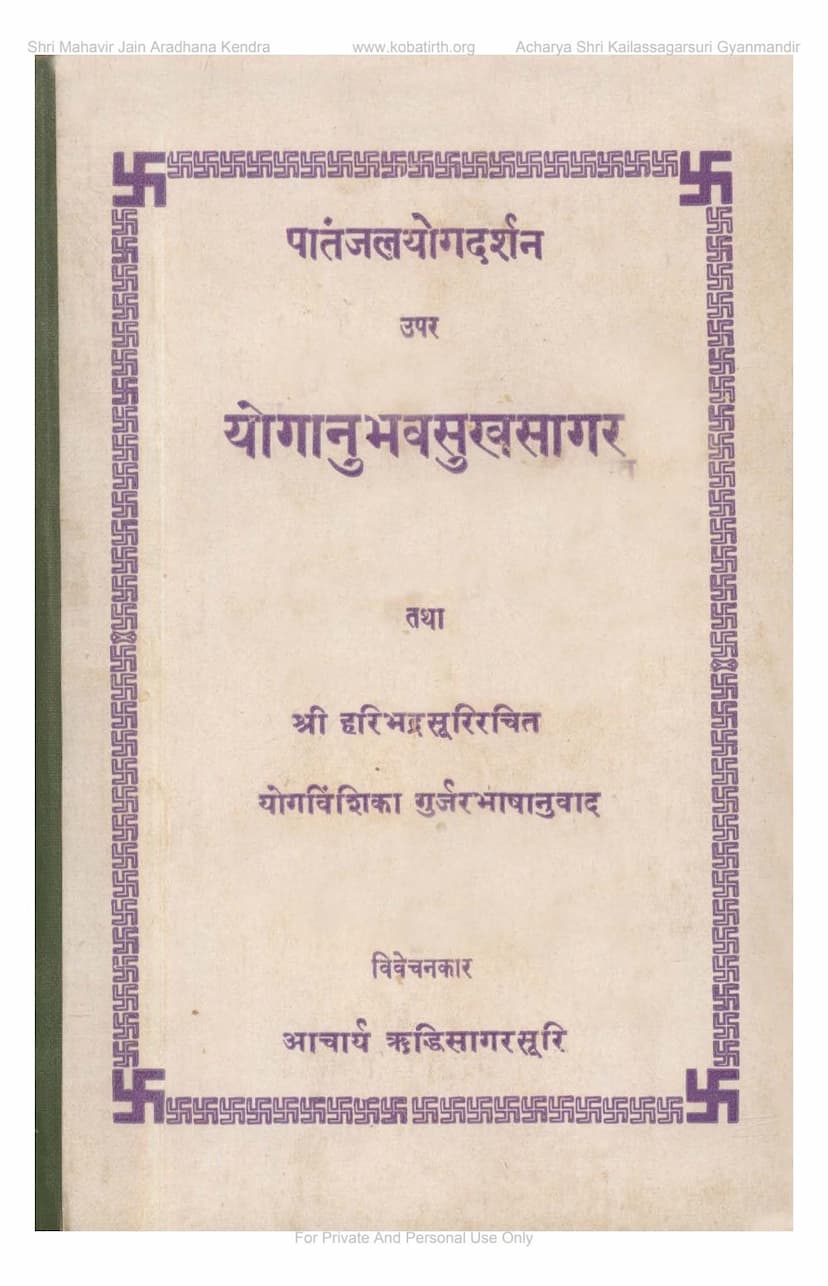Yoganubhavsukhsagar
Added to library: September 2, 2025

Summary
Here's a comprehensive summary of the Jain text "Yoganubhavsukhsagar" by Acharya Ruddhisagar, based on the provided pages:
Title: Yoganubhavsukhsagar (Ocean of Yogic Experience and Bliss) Author: Acharya Ruddhisagar Suri Publisher: Buddhisagarsuri Jain Gyanmandir Accompanying Text: Gujarati translation and commentary on Acharya Haribhadra Suri's "Yogavimshika" (Twenty Verses on Yoga).
Core Subject Matter:
The book is a significant Jain commentary and translation on the Yogasutras of Patanjali, viewed from a Jain philosophical perspective. It aims to elucidate the principles of Yoga as understood and practiced within Jainism, highlighting its spiritual and ethical dimensions.
Key Aspects and Themes:
-
Reconciling Yoga with Jainism: The primary goal of the text is to present Yoga, particularly as articulated by Patanjali, through the lens of Jain principles. Acharya Ruddhisagar emphasizes the compatibility and synthesis between the yogic path and Jain philosophy. He draws heavily on the works of previous Jain Acharyas like Haribhadra Suri and Hemchandracharya.
-
Elucidating the Yogasutras from a Jain Viewpoint: The commentary meticulously analyzes the Yogasutras, offering Jain interpretations. It addresses concepts like:
- Yoga's Definition: It begins by defining Yoga, aligning Patanjali's definition of "Yoga is the cessation of the modifications of the mind" (Yogashchittavrittinirodhah) with Jain concepts of spiritual discipline and the control of mental fluctuations.
- Citta-vrittis: The text discusses the different types of mental modifications (vrittis) and how to control them, emphasizing the Jain understanding of karma and its influence on mental states.
- The Eight Limbs of Yoga (Ashtanga Yoga): The commentary delves into each limb of Yoga (Yama, Niyama, Asana, Pranayama, Pratyahara, Dharana, Dhyana, Samadhi), explaining them from a Jain ethical and spiritual framework.
- The Concept of Ishvara: It explores the concept of Ishvara (God/Supreme Being) from both Patanjali's perspective and the Jain understanding, highlighting the Jain view of liberated souls (Siddhas) rather than an external creator God.
- Distinction between Hatha Yoga and Raja Yoga: The text distinguishes between the physical aspects of Yoga (Hatha Yoga) and the higher, mental, and spiritual aspects (Raja Yoga), noting the potential risks in some Hatha Yoga practices while emphasizing the importance of Raja Yoga for spiritual liberation.
- Karma and its Relation to Yoga: A central theme is the Jain doctrine of Karma and how yogic practices contribute to the shedding of karmic matter and the attainment of liberation (Moksha).
-
The Significance of Haribhadra Suri's Yogavimshika: The book includes a Gujarati translation and commentary on Haribhadra Suri's Yogavimshika. This text is presented as a foundational Jain work on Yoga, offering a unique perspective on spiritual development. The author highlights Haribhadra Suri's innovative approach to Yoga within the Jain context, which he considers unparalleled in the broader Indian Yoga literature.
-
The Role of the Preceptor (Guru): The text, through its introductory sections and dedications, underscores the importance of the Guru (Acharya Buddhisagar Suri and the lineage) in spiritual guidance and the transmission of knowledge. The author, Ruddhisagar, expresses deep reverence for his Guru.
-
The Decline of True Knowledge and the Need for Revival: The "Prastavna" (Introduction) section laments the decline of traditional Indian, particularly Aryavarta's (India's) spiritual heritage due to foreign influences and a loss of self-identity. It emphasizes the diminishing study of Sanskrit and classical philosophical texts, which poses a threat to spiritual knowledge and culture. The author sees this book as a contribution to reviving and disseminating this vital knowledge, particularly within the Gujarati-speaking community.
-
Jain Philosophy's Emphasis on Anekanta (Plurality of Viewpoints): The text touches upon the Jain principle of Anekanta, suggesting that true spiritual understanding comes from appreciating multiple valid viewpoints, not from rigid adherence to a single perspective (ekantavada). This aligns with the Jain acceptance of various spiritual paths and interpretations.
-
Practical Guidance: While deeply philosophical, the commentary aims to provide practical insights for seekers (mumukshu) to progress on the spiritual path and achieve ultimate bliss (Parmananda).
-
Language and Translation: The work is presented in Gujarati, making complex philosophical and yogic concepts accessible to a wider audience. The author expresses gratitude to those who helped with the translation and commentary, particularly Muni Raj Hemendsagarji and Pandit Bhai Shankar Bhai.
Overall Purpose and Contribution:
"Yoganubhavsukhsagar" serves as a bridge between the classical yogic tradition and Jain philosophy. Acharya Ruddhisagar's work provides a comprehensive Jain interpretation of Yoga, making the profound teachings of Patanjali and Haribhadra Suri accessible and relevant to the Jain community and beyond. It aims to guide individuals towards spiritual realization and liberation by integrating yogic practices with the principles of Jainism. The book's detailed table of contents reveals a systematic and thorough exploration of the Yogasutras from a Jain perspective.